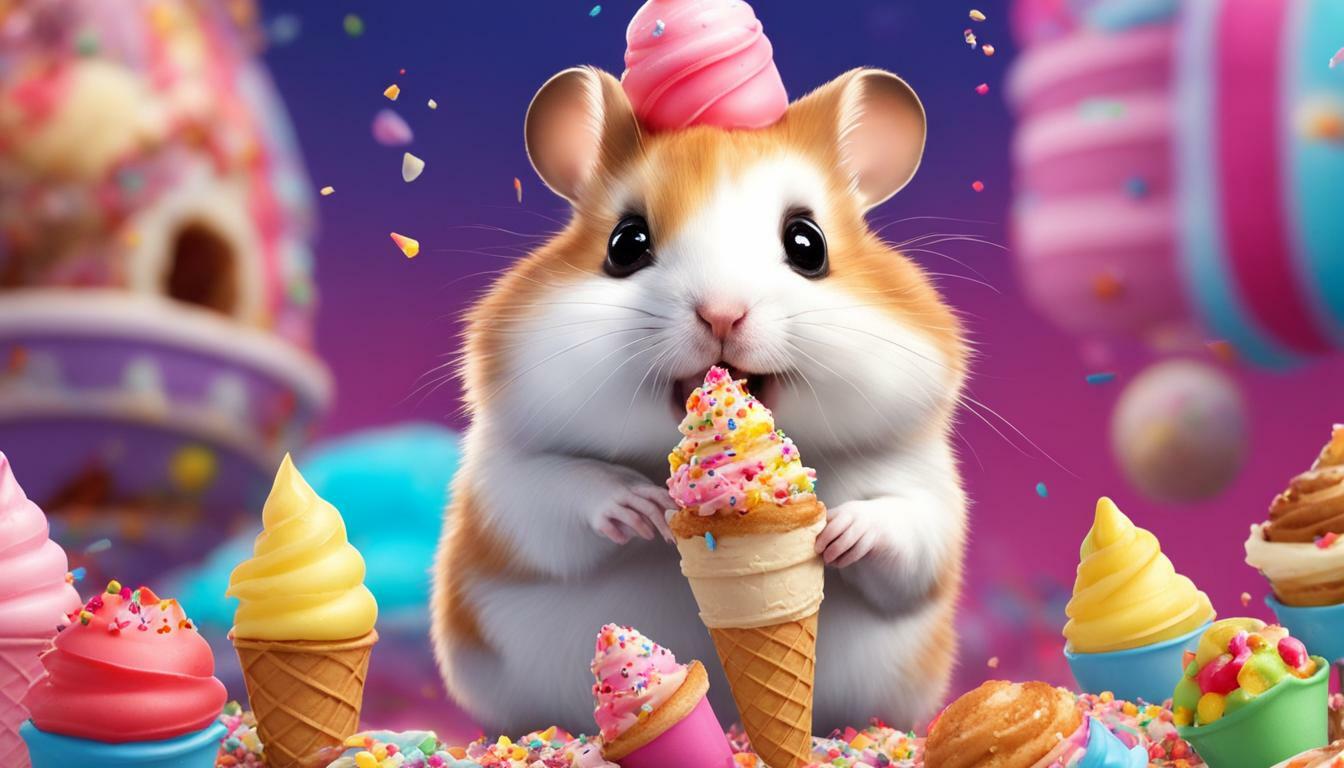Are you wondering if it’s safe for your hamster to indulge in a sweet treat like ice cream? While it may be tempting to share your favorite dessert with your furry friend, it’s important to understand the potential risks and consider healthier alternatives.
Key Takeaways:
- Hamsters should not eat ice cream due to its cold temperature, lack of nutrition, and high sugar and fat content.
- The cold temperature of ice cream can cause a sharp drop in a hamster’s body temperature, leading to health issues.
- Ice cream is not nutritionally balanced and can fill up a hamster’s stomach, leaving no room for nutritious food.
- The high sugar and fat content in ice cream can harm a hamster’s health and potentially lead to diabetes and obesity.
- Safe and nutritious alternatives to ice cream for hamsters include cheese, yogurt, and green vegetables.
Understanding the Risks
Before you share a scoop of your favorite ice cream with your furry friend, it’s important to understand the potential risks involved. While ice cream may be a delicious treat for humans, it is not suitable for hamsters. Here are some key reasons why you should avoid feeding ice cream to your hamster.
- Cold Temperature: Hamsters have small bodies that are sensitive to extreme cold. The low temperature of ice cream can cause a sharp drop in their body temperature, leading to health issues. It’s best to avoid exposing them to foods that are too cold, like ice cream.
- Lack of Nutrition: Ice cream is not a nutritionally balanced food for hamsters. It does not provide the necessary nutrients that they need to thrive. Feeding ice cream to your hamster can fill up their stomach without offering any meaningful nutrition, leaving little room for the healthy food they require.
- Excessive Sugar and Fat: The high sugar and fat content in ice cream can be harmful to hamsters. It can lead to weight gain, obesity, and even diabetes in these small creatures. It’s important to prioritize their health and avoid giving them treats that are high in sugar and fat.
Feeding ice cream to your hamster is not recommended due to these risks. However, there are alternative treats that are safe and nutritious for your furry friend. Consider offering them small pieces of cheese, a spoonful of yogurt, or some fresh green vegetables. These options provide better nutrition and are a healthier substitute for ice cream.
Remember, when it comes to your hamster’s diet, it’s crucial to maintain a balanced approach. Treats should be offered in moderation and should not make up the majority of their diet. Consult with a veterinarian for guidance on proper portion sizes and to ensure your hamster’s overall health and well-being.
| Risks of Feeding Ice Cream to Hamsters: | Alternatives to Ice Cream for Hamsters: |
|---|---|
| Cold temperature can cause a sharp drop in body temperature, leading to health issues. | Cheese |
| Ice cream lacks proper nutrition for hamsters, filling up their stomach without providing essential nutrients. | Yogurt |
| High sugar and fat content in ice cream can lead to weight gain, obesity, and diabetes in hamsters. | Green vegetables |
The Cold Temperature Factor
Hamsters have a smaller body size compared to humans, making them susceptible to temperature changes, especially when it comes to cold foods like ice cream. The cold temperature of ice cream can cause a sharp drop in a hamster’s body temperature, which can lead to health issues such as hypothermia and even death.
Unlike humans, hamsters do not have layers of fat or thick fur to protect them from extreme cold. Their bodies are not equipped to handle the low temperatures that ice cream can bring. Consuming ice cream can quickly lower their body temperature, putting them at risk of developing respiratory problems, digestive issues, and even frostbite.
It is essential to remember that hamsters are highly sensitive to their environment, and exposing them to extreme cold can have severe consequences for their health. Therefore, it is best to avoid feeding ice cream or any other frozen treats to your hamster.
| Why ice cream is not suitable for hamsters | Alternatives to ice cream |
|---|---|
|
|
To keep your hamster healthy and happy, opt for safe alternatives to ice cream. Cheese, yogurt, and green vegetables are nutritious and can provide a variety of flavors and textures for your furry friend. These alternatives are not only safer for their delicate digestive systems but also offer essential vitamins and minerals for their overall well-being.
Remember, when it comes to treating your hamster, their health should always be your top priority. By avoiding ice cream and opting for healthier alternatives, you can ensure that your hamster enjoys a balanced diet and lives a long, happy life.
Lack of Nutrition
While ice cream may be a tasty treat for humans, it falls short in terms of nutritional content for our small furry friends. Hamsters require a well-balanced diet to maintain their health and wellbeing. Ice cream, however, does not offer the necessary nutrients that hamsters need. It is high in sugar, fat, and calories, but lacks essential vitamins, minerals, and proteins that are vital for their growth and development.
Feeding ice cream to hamsters can be detrimental to their overall health. Instead of providing them with the necessary nutrition, it can fill up their stomachs, leaving no room for more nutritious foods. This can lead to deficiencies in their diet, which can impact their immune system, digestion, and overall vitality. It is important to prioritize their nutritional needs and choose treats that offer a better balance of essential nutrients.
When selecting treats for your hamster, opt for alternatives that are safe and nutritious. Cheese, yogurt, and green vegetables are all great options that can provide better nutritional value compared to ice cream. These alternatives offer a good balance of vitamins, minerals, and proteins that contribute to your hamster’s overall health and wellbeing. Remember to introduce new treats gradually and in moderation, ensuring that they are appropriate for your hamster’s specific dietary needs.
| Ice Cream | Cheese | Yogurt | Green Vegetables |
|---|---|---|---|
| High in sugar and fat | Good source of protein and calcium | Contains live bacteria that aid digestion | Rich in vitamins and fiber |
| Low in essential nutrients | Not excessive in calories | Can help regulate gut health | Supports overall health and digestion |
| Can lead to obesity and diabetes | Should be given in small quantities | Choose plain, unsweetened options | Offer a variety for a well-rounded diet |
By understanding the importance of a balanced diet and making informed choices about treats, you can ensure that your hamster remains healthy and happy. Remember to consult with a veterinarian if you have any concerns or questions regarding your hamster’s diet or overall wellbeing. Your furry friend deserves the best care and nutrition, so opt for safe treats that will contribute to their long and happy life.
Excessive Sugar and Fat
The indulgent sweetness and richness that make ice cream so delicious for us can actually be harmful to the health of our hamsters. Feeding them sweets, especially those high in sugar and fat, can have negative consequences for their well-being. Hamsters have small bodies and delicate digestive systems that are not equipped to handle the high sugar and fat content found in ice cream.
Excessive sugar consumption can lead to obesity and diabetes in hamsters. These conditions can have serious health implications and potentially shorten their lifespan. Additionally, the high fat content in ice cream can contribute to weight gain and other health issues. It is important to prioritize the overall health and nutrition of our furry friends by providing them with appropriate treats.
When it comes to hamsters and dairy products, it is important to exercise caution. While some hamsters may tolerate small amounts of dairy, others may be lactose intolerant. Dairy products like ice cream can cause digestive upset, including diarrhea, in hamsters. It is best to avoid feeding them dairy-based treats to prevent any potential discomfort or health issues.
Instead of giving our hamsters ice cream or other sugary treats, we can opt for healthier alternatives. Hamsters can enjoy small amounts of cheese, which can provide them with protein. Yogurt is also a good option, but it should be unsweetened and free of any artificial additives. Green vegetables like kale or broccoli can be a nutritious addition to their diet as well. By choosing these alternatives, we can provide our hamsters with treats that are not only delicious but also beneficial for their health.
| Sugar and Fat Risks in Ice Cream for Hamsters |
|---|
| Excessive sugar consumption can lead to obesity and diabetes in hamsters. |
| The high fat content in ice cream can contribute to weight gain and other health issues. |
| Dairy products like ice cream can cause digestive upset, including diarrhea, in some hamsters. |
| Healthier alternatives for hamsters include small amounts of cheese, unsweetened yogurt, and green vegetables. |
Alternatives to Ice Cream
Fortunately, there are plenty of tasty and safe alternatives to ice cream that can satisfy your hamster’s cravings without compromising their health. While ice cream may be tempting to share with your furry friend, it is important to remember that their small bodies are not equipped to handle the cold temperature, lack of nutrition, and excess sugar and fat found in this popular treat. But don’t worry, there are other options that can provide a delicious and nutritious experience for your hamster.
Cheese is a great alternative to ice cream for hamsters. It is high in protein and calcium, which are essential for their growth and development. You can offer small pieces of low-fat cheese as an occasional treat. Just be sure to monitor the portion size, as excessive cheese consumption can lead to weight gain.
Yogurt is another excellent choice for hamsters. Opt for plain, unsweetened yogurt to avoid the added sugars that can be harmful to their health. Yogurt contains beneficial probiotics that promote a healthy digestive system for your hamster. You can occasionally offer a small dollop of yogurt as a special treat.
Green vegetables are also a safe and nutritious option for hamsters. Vegetables like broccoli, spinach, and kale provide essential vitamins and minerals that support their overall well-being. Remember to wash the vegetables thoroughly and cut them into small, manageable pieces to prevent choking hazards. Introduce new veggies gradually to avoid digestive upset.
| Treat | Nutritional Benefits |
|---|---|
| Cheese | High in protein and calcium |
| Yogurt | Contains probiotics for a healthy digestive system |
| Green vegetables | Provides essential vitamins and minerals |
Remember to offer these alternatives in moderation. Treats should only make up a small portion of your hamster’s diet, with the majority consisting of a balanced and nutritious hamster food. By choosing safe and appropriate treats for your furry friend, you can ensure their enjoyment while prioritizing their health and well-being.
Creating a Balanced Diet
While treats can be a fun addition to your hamster’s diet, it’s crucial to maintain a balanced and nutritious eating plan for their overall well-being. Hamsters have specific dietary requirements, and it’s important to ensure they receive the right nutrients to support their growth and health.
When incorporating treats into your hamster’s diet, it’s essential to do so in moderation. Treats should only be given as a small part of their overall diet, and their primary source of nutrition should come from a well-balanced hamster food. This will ensure that they are getting all the essential vitamins, minerals, and nutrients they need.
Instead of relying heavily on treats like ice cream, consider offering your hamster healthier alternatives. Cheese and yogurt can be excellent choices, as they provide calcium and protein while still being enjoyable for your furry friend. Additionally, offering small portions of fresh, nutrient-rich vegetables like carrots or leafy greens can provide added variety to their diet.
Table 1: Safe and Nutritious Treats for Hamsters
| Treat Options | Benefits |
|---|---|
| Cheese | Provides calcium and protein |
| Yogurt | Contains beneficial probiotics and protein |
| Fresh Vegetables | Offers essential vitamins and minerals |
Remember, even when offering these treats, portion control is key. Too many treats can lead to weight gain and other health issues. It’s important to monitor your hamster’s weight and adjust their diet accordingly. If you notice any changes in their eating habits, weight, or overall health, consult a veterinarian for guidance.
By maintaining a balanced diet for your hamster and offering safe and nutritious treats, you can ensure that they stay healthy and happy. Treat time can still be enjoyable for both you and your furry friend, while also prioritizing their well-being and longevity.
Monitoring Your Hamster’s Health
As a responsible hamster owner, it’s essential to keep a close eye on your furry friend’s health and well-being, especially when introducing new treats like ice cream. While ice cream may seem like a tempting treat to share with your hamster, it’s important to remember that it can have adverse effects on their health.
One of the key aspects to monitor when introducing treats is your hamster’s weight. Regularly weigh your hamster to ensure they are maintaining a healthy weight. Excessive consumption of high-sugar and high-fat foods like ice cream can lead to weight gain and obesity, which can have detrimental effects on their overall health.
In addition to monitoring weight, be observant of any changes in your hamster’s behavior or appearance. Look out for signs of digestive issues such as diarrhea or lack of appetite, as this may indicate that the ice cream or other treats are not agreeing with their system. It’s also important to notice any signs of lethargy or other abnormal behaviors, as these could be indications of underlying health problems.
In case you notice any concerning changes in your hamster’s health or if you have any doubts about the suitability of a specific treat, don’t hesitate to consult with a veterinarian who specializes in small animals. They will be able to provide professional advice and guidance tailored to your hamster’s specific needs.
| Signs to Monitor | Potential Health Issues |
|---|---|
| Weight gain or loss | Obesity or malnutrition |
| Diarrhea or lack of appetite | Digestive issues |
| Lethargy or abnormal behavior | Underlying health problems |
By closely monitoring your hamster’s health and being attentive to any changes, you can ensure their well-being and make informed decisions about their treats. Remember, opting for safe treats and a balanced diet is the best way to keep your hamster happy and healthy.
The Joy of Treat Time
Treating your hamster to something special can be a delightful experience for both of you, fostering a deeper bond and showing your affection in a tangible way. While it’s important to choose treats that are safe and healthy for your furry friend, there are plenty of options that can provide a tasty and nutritious alternative to ice cream.
One great treat option for hamsters is cheese. Not only is it packed with protein, but it also comes in a variety of flavors that your hamster is sure to enjoy. Just make sure to offer small portions, as cheese can be high in fat. Yogurt is another excellent choice, as it contains beneficial probiotics that can promote a healthy digestive system for your hamster.
In addition to cheese and yogurt, you can also offer your hamster a variety of green vegetables. Broccoli, spinach, and kale are all great options that provide essential vitamins and minerals. Just be sure to wash them thoroughly and chop them into small, manageable pieces for your hamster to enjoy.
To ensure a balanced diet for your hamster, it’s important to incorporate these treats in moderation. A small piece of cheese or a spoonful of yogurt once or twice a week, along with a few vegetable treats, will keep your hamster happy and healthy. Remember to consult your veterinarian if you have any concerns about your hamster’s diet or health.
| Treat Option | Benefits |
|---|---|
| Cheese | High in protein, variety of flavors |
| Yogurt | Contains beneficial probiotics |
| Green Vegetables | Provide essential vitamins and minerals |
Conclusion
When it comes to hamsters and their diet, it’s crucial to remember that not all treats are safe, and ice cream falls into that category. Hamsters should not eat ice cream because it is too cold, lacks nutrition, and contains too much sugar and fat. The cold temperature of ice cream can cause a sharp drop in a hamster’s body temperature, leading to health issues. Additionally, ice cream is not nutritionally balanced and can fill up a hamster’s stomach, leaving no room for nutritious food.
The high sugar and fat content in ice cream can harm a hamster’s health and potentially lead to diabetes and obesity. Feeding ice cream to hamsters is not recommended. Instead, consider offering alternatives such as cheese, yogurt, and green vegetables, which provide better nutrition for your furry friend. These alternatives are not only delicious but also help maintain a balanced diet for your hamster.
When treating your hamster, always prioritize their well-being by choosing safe and nutritious options. While it may be tempting to share your favorite sweet treat with them, remember that their small bodies require specific care and attention. By selecting treats that are specifically designed for hamsters or consulting with a veterinarian, you can ensure that your pet enjoys their treat time while staying healthy and happy.
FAQ
Can hamsters eat ice cream?
No, hamsters should not eat ice cream. It is too cold, lacks nutrition, and contains too much sugar and fat.
Why is ice cream bad for hamsters?
Ice cream is bad for hamsters because the cold temperature can cause a sharp drop in their body temperature, it lacks nutritional value, and the high sugar and fat content can harm their health.
What can happen if I feed my hamster ice cream?
Feeding ice cream to your hamster can lead to health issues, such as a drop in body temperature, obesity, and diabetes.
What are some alternatives to ice cream for hamsters?
Instead of ice cream, you can give your hamster treats like cheese, yogurt, and green vegetables. These provide better nutrition and are safer for your furry friend.
How should I create a balanced diet for my hamster?
It’s important to provide a balanced diet for your hamster. Incorporate treats into their overall diet, but remember to practice portion control to avoid overfeeding.
How can I monitor my hamster’s health when giving treats?
Keep an eye on your hamster’s weight and look out for any signs of potential health issues. If you’re unsure, consult a veterinarian for guidance.
Can treats be a bonding experience with my hamster?
Absolutely! Giving treats to your hamster can be a joyful experience and help strengthen your bond. Just remember to choose safe and appropriate treats.




